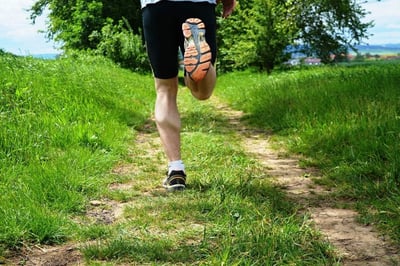There’s at least one in every wellness program. Sometimes it’s the wellness coordinator who’s lean and mean, positive, and practically eats kale for a living.
Sometimes it’s the hard-charging CEO who never misses a workout and avoids fast food, despite a hectic schedule.
And sometimes it’s an employee, participant, or member who sets an example for healthy living that inspires others to eat a little better, exercise a little more, get a check-up, or try a little harder to make smart lifestyle choices.
You probably know somebody like this in your organization. Maybe you’re one of them. Or maybe you’re looking for a few more to help give your wellness program a boost, feature in your newsletter, or highlight on your blog.
In a single weekend in late September, one Wellsource team member ran a 26.2-mile marathon. Another finished a 100-mile ultra-marathon. And now other team members are talking about logging a few more steps per day, getting on the treadmill in our exercise room, and putting plans in place to lose weight and keep it off. Your wellness champions can make a difference.
Motivation to change
Having someone on your team or in your organization that models healthy behaviors can have a positive impact on engagement, participation rates, and the health of your population.1
“Every organization needs someone who can be a champion or ambassador for their wellness program,” says Wellsource Director of Health and Research Dr. Joe Raphael. “When people see others succeed at losing weight, exercising, or eating healthier, it can give people the nudge they need to change their own behaviors to improve their health.”
But just exactly how far can you run to promote health and show people what’s possible? Line up the right tools like a health risk assessment, wellness initiatives tailored to your population, and incentives to increase engagement, and you’ll be headed in the right direction. And your wellness champions can help lead the way.2
Wellness champions can make a difference
How far can you run to promote health? As far as possible to inspire people to change. That’s what Froedtert Health Director of Business Development Barbra Fagan thinks. She helps employers in Wisconsin design wellness programs to meet the needs of their own populations. And when she’s not at work, you’ll find her on the trail training to run a 100-mile ultramarathon.
Wellness champions can have a big impact within your organization by motivating others to change their own behaviors, leading to improved health outcomes that can positively impact your bottom line.
We even have some of our own wellness champions at Wellsource:
Tackling the 26.2-mile marathon
Wellsource Wellness Consultant Shawn Tausz Meyers ran the 26.2-mile Bellingham Bay Marathon in Bellingham, Wash., on Sept. 25. She finished the race in 3:57:10 and won the third place spot in her age group. It’s one of many marathons Tausz Meyers has finished, and gives her the chance to check off another state on her bucket list to run a marathon in all 50 states.
But just because Tausz Meyers has run several marathons before, doesn’t mean that putting in the miles to train for this marathon was any easier.
She ran three days a week. And she had a plan. The three runs included a tempo and speed workout. She used a treadmill at the gym to tackle those workouts while her daughter played in the gym daycare. And she carved out time for one long run a week (two to three hours in length), starting early in the morning.
“I’m busy just like everybody else,” says Tausz Meyers. “It wasn’t easy to train for a marathon with work, taking care of my daughter, and other responsibilities. But I know how important it is to stay active. Checking off one more state to accomplish my goal to run a marathon in every state felt great, too.”

Running a 100-mile ultramarathon
When the 350-plus runners took off on the 26.2-mile course in Bellingham, another Wellsource employee was just beginning a different kind of race. Health and Marketing Writer Evan Jensen was among a group of 150 runners to tackle the Mountain Lakes 100-Mile Ultramarathon in Oregon’s Mount Hood National Forest.
For the next 26 hours and 14 minutes, he ran on mountain trails and gulped down more than a gallon of sports drink. He munched his way through 9,000 calories (peanut butter and jelly sandwiches, gummy bears, potato chips, grilled cheese sandwiches, broth, quesadillas, and mashed potatoes) to go the distance. (Note: Fast carbs and foods high in sugar, salt, and fat work for running long distances, but shouldn’t be part of your daily diet.) When the sun set, he turned on a headlamp and flashlight, and kept going until he reached the finish line.
“You never really know how a marathon or a 100-mile race is going to turn out,” says Jensen. “You put in the training, but there’s always the chance you might trip and fall, have stomach issues, or develop muscle soreness. This turned out to be a great race.”
During the training months leading up to the 100-mile race, Jensen ran 50 to 80 miles a week. And hit the gym three days a week for strength training workouts.
“Run 100 miles, I know it seems kind of crazy or impossible to some people,” says Jensen. “But it really isn’t any different than training to complete your first 5K. Start where you’re at and gradually increase the amount of time or distance you walk or run. Over time, you’ll get stronger. You’ll get faster. Stick with it, and you might even be surprised at what you can accomplish.”
Who are the wellness champions in your organization? Send us an e-mail and we’ll consider highlighting the people on your team in an upcoming issue of WellnessRx and in our blog.
1. Terry, P.E. (2013). Tapping passion: the untold talents of wellness champions, ambassadors, and peer educators. American Journal of Health Promotion, 28(1):TAHP1. doi: 10.4278/ajhp.28.1.tahp.
2. Berry, L.L, Mirabito, A.M., Baun, W.B. (2010, December). What’s the hard return on employee wellness programs? Harvard Business Review, 88(12):104-112.







